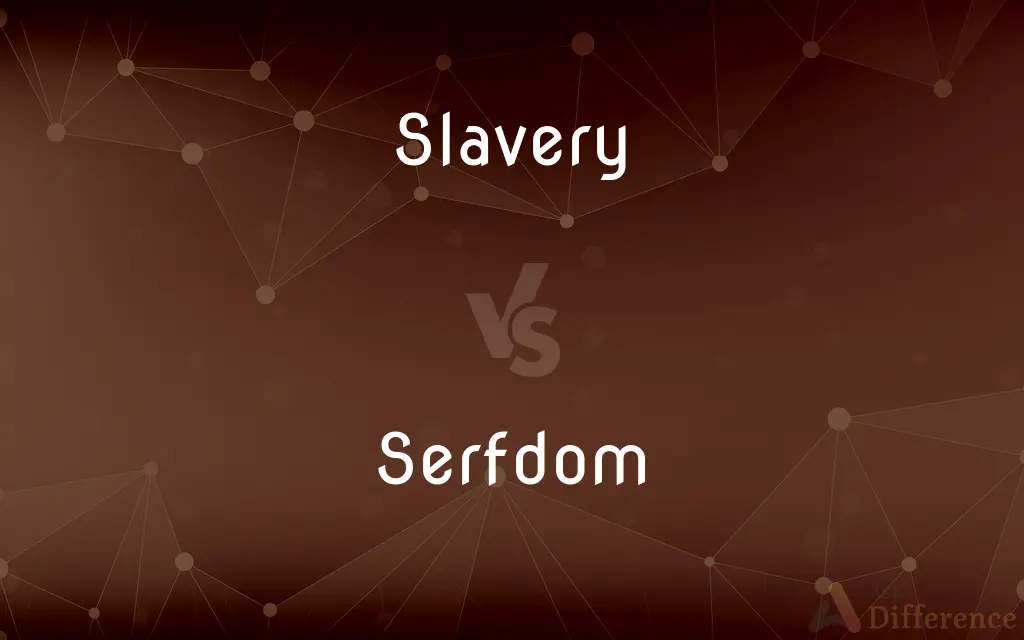Slavery vs. Serfdom — What's the Difference?
Edited by Tayyaba Rehman — By Maham Liaqat — Updated on April 2, 2024
Slavery involves ownership of individuals as property, with no personal freedom, while serfdom binds individuals to land, granting them limited rights and obligations to a lord.

Difference Between Slavery and Serfdom
Table of Contents
ADVERTISEMENT
Key Differences
Slavery and serfdom represent two historical systems of labor and social hierarchy, each with distinct characteristics and implications for those within the system. Slavery, a practice dating back to ancient civilizations, involves the ownership of individuals by others, treating humans as property that can be bought, sold, and subjected to forced labor with no autonomy or rights. Serfdom, which became prevalent in medieval Europe, particularly under the feudal system, did not involve the outright ownership of individuals but rather tied serfs to the land they worked on. Serfs were bound to the estate of a lord and had certain rights in their dwelling and land use but were required to work the lord's land and pay rent or labor in exchange.
Slaves were considered legal property of their owners, who had nearly absolute power over their lives and labor. Unlike slaves, serfs could not be sold apart from the land, had some personal rights, and were part of a reciprocal, though highly unequal, relationship with the landowning nobility.
While both systems severely restricted personal freedom and forced individuals into labor, serfdom allowed for a degree of personal and familial stability within the constraints of the feudal estate. Serfs had a vested interest in the land they worked, and their obligations, as well as protections under the system, were regulated by tradition and law. Slavery, by contrast, offered no such security or rights, as slaves were subject to the will of their owners without legal recourse.
The abolition movements of the 18th and 19th centuries led to the gradual decline of slavery, particularly in the Western world, culminating in legal bans on the slave trade and the practice of slavery itself. Serfdom also declined with the rise of more modern economic systems and societal changes, with reforms and revolutions gradually eradicating the legal and social structures that supported serfdom.
Both slavery and serfdom are viewed in contemporary times as oppressive and unjust systems that deprived individuals of basic human rights and dignity. The historical legacy of both continues to influence discussions on human rights, labor laws, and social justice.
ADVERTISEMENT
Comparison Chart
Definition
The condition in which individuals are owned by others, without personal freedom or rights.
A system where individuals are bound to work on a lord’s land, with limited rights and obligations.
Legal Status
Slaves are considered property.
Serfs are not property but are tied to the land.
Personal Freedom
None; slaves could be bought, sold, and exploited at the owner's will.
Limited; serfs had certain personal rights and could not be sold apart from the land.
Labor
Forced labor without compensation.
Required to work the lord's land and possibly perform other duties, but could also cultivate their own plots.
Rights and Protections
Virtually none; subject to the whims of the owner.
Some rights, such as protection by the lord and the ability to pass land to heirs.
Historical Period
Ancient times to the 19th century, with variations across regions.
Primarily medieval Europe, fading into the modern era.
Abolition
Gradually abolished in the 18th and 19th centuries through legal reforms and abolition movements.
Declined through societal and economic changes, legal reforms, and revolutions.
Compare with Definitions
Slavery
Individuals had no rights or freedoms.
Under slavery, people were treated as property, not persons.
Serfdom
Had limited rights and obligations.
Serfs could work their own plots but owed labor to their lord.
Slavery
Worked without consent or compensation.
Slaves were forced to labor in fields and households without pay.
Serfdom
Part of the feudal system.
Serfdom was a key component of the social and economic structure of feudalism.
Slavery
Complete ownership of a person by another.
Slavery was abolished in the United States in 1865.
Serfdom
Ended through reforms and societal changes.
The emancipation reforms in 19th-century Russia abolished serfdom.
Slavery
Abolished through legal and social efforts.
The abolitionist movement was crucial in ending slavery.
Serfdom
Tied to land rather than owned by a person.
In medieval Europe, serfdom was a common form of agricultural labor.
Slavery
Predominant in many societies historically.
Ancient Rome and the pre-Civil War American South practiced slavery.
Serfdom
Could not be bought or sold separately from the land.
Serfs were transferred with land ownership.
Slavery
A condition of hard work and subjection
Wage slavery.
Serfdom
Serfdom was the status of many peasants under feudalism, specifically relating to manorialism, and similar systems. It was a condition of debt bondage and indentured servitude with similarities to and differences from slavery, which developed during the Late Antiquity and Early Middle Ages in Europe and lasted in some countries until the mid-19th century.Unlike slaves, serfs could not be bought, sold, or traded individually though they could, depending on the area, be sold together with land.
Slavery
Slavery and enslavement are both the state and the condition of being a slave, who is someone forbidden to quit their service for another person (a slaver), while treated as property. Slavery typically involves the enslaved person being made to perform some form of work while also having their location dictated by the slaver.
Serfdom
A member of the lowest feudal class, legally bound to a landed estate and required to perform labor for the lord of that estate in exchange for a personal allotment of land.
Slavery
The condition in which one person is owned as property by another and is under the owner's control, especially in involuntary servitude.
Serfdom
An agricultural laborer under various similar systems, especially in Russia and eastern Europe in the 1700s and 1800s.
Slavery
The practice of owning slaves.
Serfdom
A person in bondage or servitude.
Slavery
A mode of production in which slaves constitute the principal workforce.
Serfdom
The state of being a serf.
Slavery
The condition of being subject or addicted to a specified influence.
Serfdom
The feudal system that includes serfs.
Slavery
An institution or social practice of owning human beings as property, especially for use as forced laborers.
Serfdom
The state of a serf
Slavery
Forced labor in general, regardless of legality.
Slavery
A condition of servitude endured by a slave.
Slavery
(figuratively) A condition in which one is captivated or subjugated, as by greed or drugs.
Slavery
Covered in slaver; slobbery.
Slavery
The condition of a slave; the state of entire subjection of one person to the will of another.
Disguise thyself as thou wilt, still, slavery, said I, still thou art a bitter draught!
I wish, from my soul, that the legislature of this state [Virginia] could see the policy of a gradual abolition of slavery. It might prevent much future mischief.
Slavery
A condition of subjection or submission characterized by lack of freedom of action or of will.
The vulgar slaveries rich men submit to.
There is a slavery that no legislation can abolish, - the slavery of caste.
Slavery
The holding of slaves.
Slavery
The state of being under the control of another person
Slavery
The practice of owning slaves
Slavery
Work done under harsh conditions for little or no pay
Common Curiosities
How did slavery and serfdom end?
Slavery was abolished through legal reforms and abolition movements, while serfdom ended due to economic changes, legal reforms, and revolutions.
What is the main difference between slavery and serfdom?
Slavery involves outright ownership of individuals, while serfdom ties individuals to land with some rights and obligations.
Why is serfdom often associated with medieval Europe?
Because it was a fundamental part of the feudal system prevalent in Europe during the Middle Ages.
Did serfs receive any compensation for their labor?
Serfs did not receive wages, but they could cultivate their own plots and keep the produce, unlike slaves who were not compensated.
Were there any rights or protections for slaves?
Slaves had virtually no rights or protections and were entirely at the mercy of their owners.
Did slavery exist in regions outside of the United States and ancient Rome?
Yes, slavery has been practiced in various forms across the world, including in Africa, Asia, and the Middle East.
Could serfs be sold like slaves?
No, serfs were tied to the land and could not be sold independently of it.
Could a serf become free?
It was possible in some regions through manumission, marriage, or escaping to a city, but this varied widely.
What was the role of the lord in serfdom?
The lord provided protection and land to work on in exchange for labor and other obligations from the serfs.
What were the social impacts of abolishing slavery and serfdom?
The abolition of both systems led to significant social and economic changes, including shifts in labor systems, social hierarchies, and legal rights.
Share Your Discovery

Previous Comparison
Tube vs. Tub
Next Comparison
Beige vs. FawnAuthor Spotlight
Written by
Maham LiaqatEdited by
Tayyaba RehmanTayyaba Rehman is a distinguished writer, currently serving as a primary contributor to askdifference.com. As a researcher in semantics and etymology, Tayyaba's passion for the complexity of languages and their distinctions has found a perfect home on the platform. Tayyaba delves into the intricacies of language, distinguishing between commonly confused words and phrases, thereby providing clarity for readers worldwide.
















































